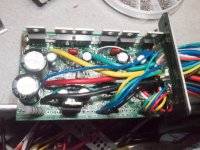Not that much more, they're small geared hubmotors that can't shed heat very well.
They also have plastic gears that can only take so much torque. Too much current means too much torque, and they can strip or break.
Same with their built in clutch that lets the wheel freewheel around the motor when you're not powering it, so it doesn't drag and slow you down. That can only handle so much torque.
larger DD hubmotors can cool themselves better, so you could put twice the power than its' rated for, in relatively short bursts, and it'd do just fine. No gears, no clutch, so they won't break those from torque.
But the small geared hubs can't handle that much more than their ratings.
To avoid overheating the hub, you may have to stay at slower (normal bicycle pedalling) speeds, so air resistance wouldn't force you to use more power.
Going up a hill, or riding into a strong headwind, could take enough power to overheat the hub.
Similarly, lots of stop and start traffic could do it too, especially if the bike, including rider and anything you're carrying, is heavy.
Or it might work fine. Depends on conditions and how you use it.
I'd still recommend some sort of temperature sensor, even if it's just a BBQ thermometer with the sensor stuffed into the axle between the metal and the wires. If you don't have a way to monitor things, then usually the first time you know it's too much for it is when it stops working.

I was going to suggest checking out the http://ebikes.ca/simulator to see what happens in various situations. but I didn't see a motor listed that might be like yours, and I couldn't setup an "accurate" basic simulation with other motors since we have no info in this thread on your bike/etc., or terrain, wind, weight, traffic, or other conditions.


